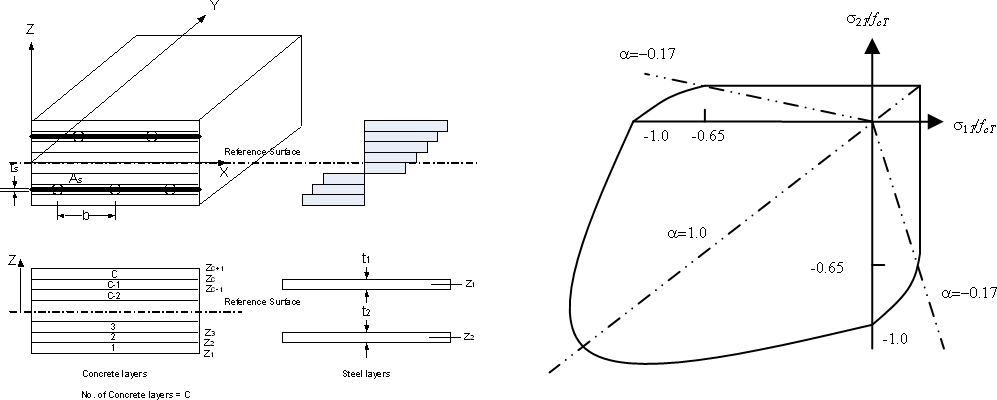
engineering & technology publications
ISSN 1759-3158
INNOVATION IN COMPUTATIONAL STRUCTURES TECHNOLOGY
A Rectangular Layered Plate-Shell Element for Nonlinear Analysis of Reinforced Concrete Slabs at Elevated Temperature
School of Civil and Environmental Engineering, The University of New South Wales, Sydney, Australia
For the layered representation of Figure 1, the reinforcement is treated in the familiar `smeared' fashion, and the temperatures are assumed to be uniform throughout each layer. The numerical procedure models the concrete nonlinearity by constitutive models that can be implemented easily, and which are assumed valid at elevated temperatures and which are based on the biaxial strength envelope shown in Figure 1 together with the Eurocode 4 degraded material properties. When the maximum principal stress at a Gauss point reaches the concrete tensile strength, cracks form in planes perpendicular to the direction of the maximum principal stress, with the elastic properties reducing to zero in the maximum principal stress direction. When the minimum principal stress also reaches the tensile strength, a second crack plane perpendicular to the first one forms, and an appropriate property matrix is then used. The shear modulus in the property matrix accounts for aggregate interlock and dowel action, tension-stiffening effects are included. These algorithms have been used elsewhere by the authors to derive efficient numerical representation [2].
The efficiency and accuracy of the element are demonstrated by comparisons with independent numerical results obtained for RC slabs under fire attack reported by Huang [3]. In particular, it is shown in the paper that the response of an RC slab with simple edge supports differs significantly from that with longitudinal restraint of its edges, which may be more typical of a building frame. The interaction of forces in these cases is complex, from membrane compression to a final tensile regime in the case of a slab that is fully restrained.
- 1
- Y.X. Zhang, K.S. Kim, "Two simple and efficient displacement-based quadrilateral elements for the analysis of composite laminated plates", International Journal for Numerical Methods in Engineering 61, 1771-1796, 2004. doi:10.1002/nme.1123
- 2
- Y.X. Zhang, M.A. Bradford, R.I. Gilbert, "A new triangular layered plate element for the nonlinear analysis of reinforced concrete slabs", Communications in Numerical Methods in Engineering, 2006 (in press). doi:10.1002/cnm.840
- 3
- Z. Huang, I.W. Burgess, R.J. Plank, "Modelling membrane action of concrete slabs in composite buildings in fire. I: Theoretical development", Journal of Structural Engineering ASCE, 129(8), 1093-1102, 2003. doi:10.1061/(ASCE)0733-9445(2003)129:8(1093)
purchase the full-text of this chapter (price £20)
go to the previous chapter
go to the next chapter
return to the table of contents
return to the book description
purchase this book (price £95 +P&P)
